Varalakshmi and Navarathri pooja, significant religious functions celebrated in India. The former, celebrated in South-India, the latter all over India.
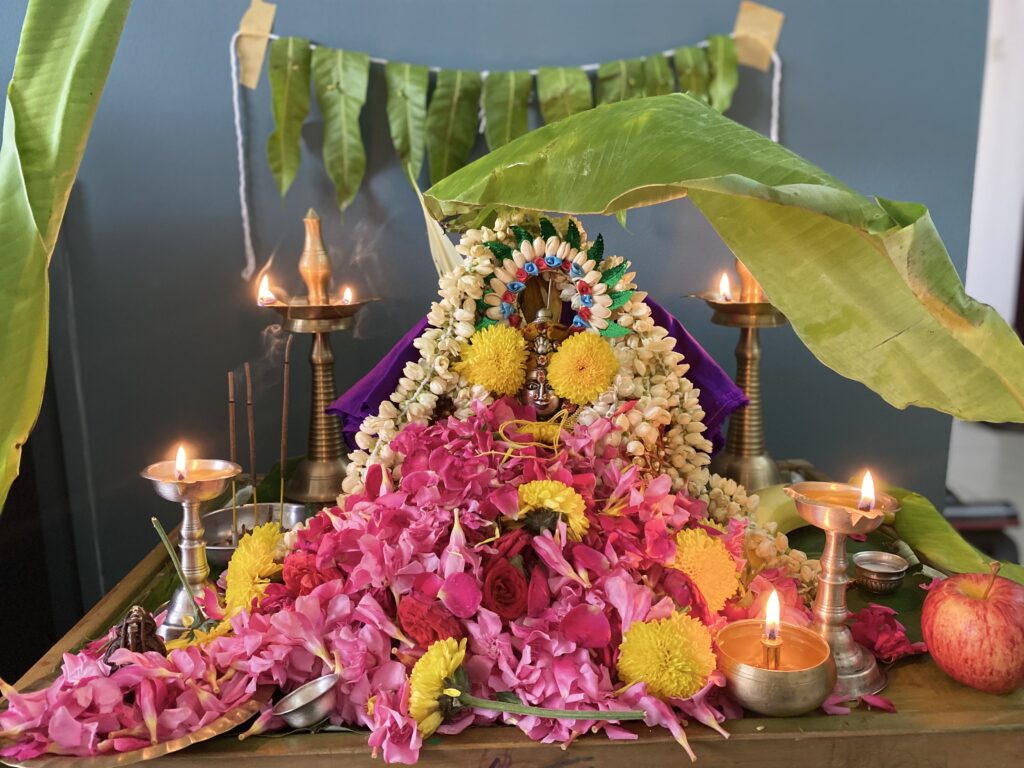
People who are new to this tradition might find the heading pretty weird, what is kalasam and what do jodanai mean. Kalasam is the symbolic representation of the God/Goddess for whom we perform the pooja. Every big pooja/function in Hindu tradition involves the use of Kalasam. The Kalasa/Kalasam/Purna-Kalasha is a symbol of abundance and "source of life" in the Vedas.
The Kalasha, believed to contain amrita, the elixir of life, viewed as a symbol of abundance, wisdom, and immortality. A symbol of auspiciousness, worshiped in all Hindu festivities and functions from childbirth, marriage, house-warming, and many more festivities that cannot be included in one single post.
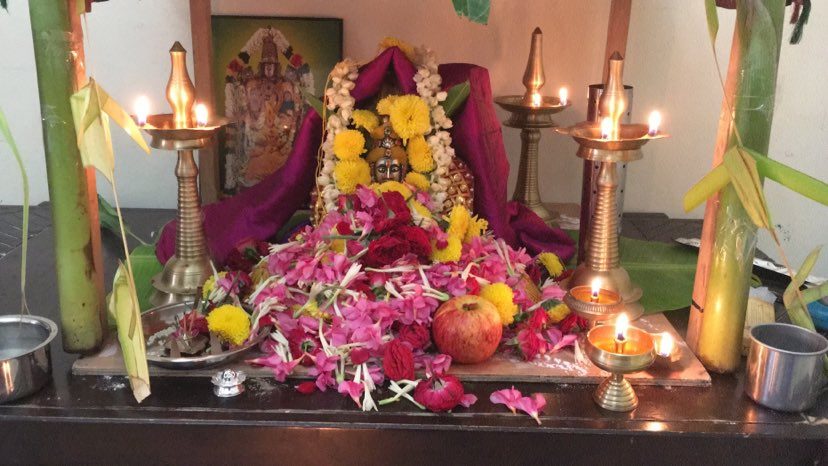
Navrathri and Varalakshmi pooja are two important festivals, as a tambrahm, i eagerly look forward to. Reason is, I personally get to decorate this kalasam/Kalash. The Woman of the house-hold does the decoration/jodanai of the Kalasam. If it is a joint-family, elders in the family will take incharge and rest will take care of other preparations for the pooja.
Every house-hold has different tradition and ritual for the kalasam jodanai/decoration, i m listing the way i do. For us, the kalasam is important for varalakshmi vratham and navarathi. The exception for navrathri would be the fresh mango leaves and the thazhampoo/Fragrant screw pine flower, because they would dry, during the 9 day festivity.
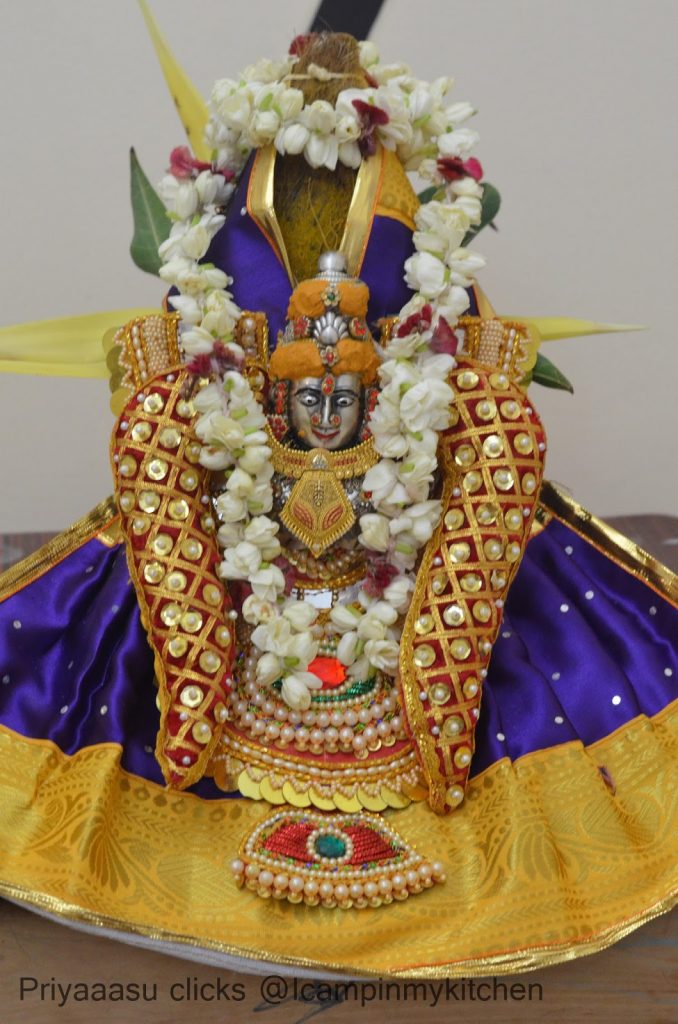
Varalakshmi Vratham, Initiation
Varalakshmi poojai, done by married women. The first Varalakshmi Vratham after marriage, should be initiated by your mother-in-law or any elder of the family, after which you can do the pooja on your own from next year . By initiation i mean, your Mugam/Goddess face will be kept along with your Mother-in-law's kalasam.
The Preparations
Previous day to the pooja, wash, clean and wipe all the pooja vessels. I use silver pot for the kalasam, which is kept neatly wrapped in a piece of cloth, along with the Mugam. I wash it with little water and soap, and wipe well to my satisfaction. Some, like my mom, till date use brass pot for the kalasam, and it depends on their tradition.
The Kalasam for the Varalakshmi pooja is decorated the previous night. First let us prepare the place where you are going to place the kalasam and do the pooja.
Sweep, clean & Kolam
Neatly sweep and mop the place. Do Ezhakolam/Kolam using rice flour/ rangoli using wet rice flour. The kalasam will sit in the center of the mandapam, decorate the center, with padi kolam. Adorn the corners of the mandapam with simple border with rice flour. It is better to do kolam early, so it drys well, before placing other decorations.
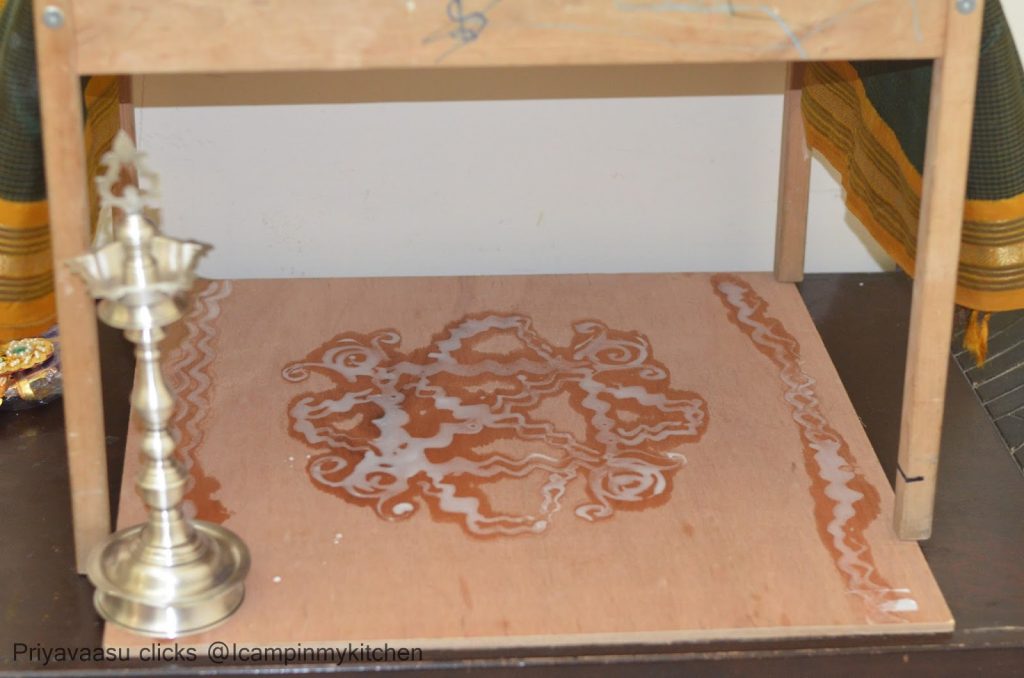
The Altar/Mandapam Setup
We make a setup of mandapam/small temple like decoration. i used my coffee table and placed a plain wooden plank for doing kolams and used my kid's old study table as mandapam.
Decorate the corners of the mandapam with Vazhaikannu/Baby Banana tree and a thoranam/garland of fresh mango leaves, symbolising auspiciousness/Subham.
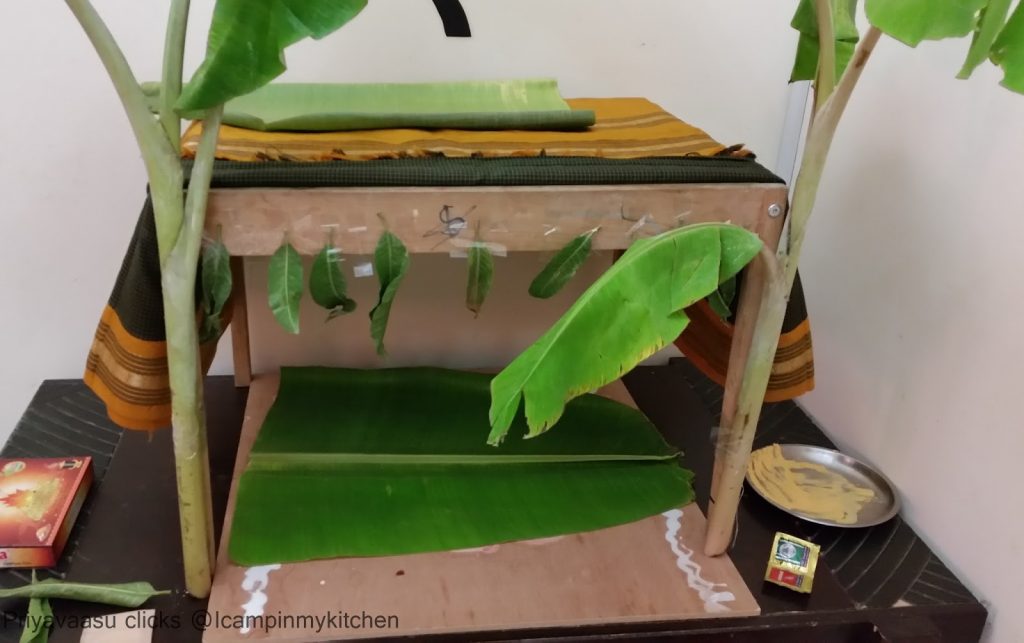
Cover the top of the mandapam, with a silk cloth, for aesthetic appeal. I use my silk saree to cover it. Now the Temple setup is ready. Let us start decorating the main kalasam.
i use the same Goddess mugam/face, for varalakshmi vratham and navarthi. The mugam/face comes with all the decoration and jewelry, and is available in all leading jewelry shops.
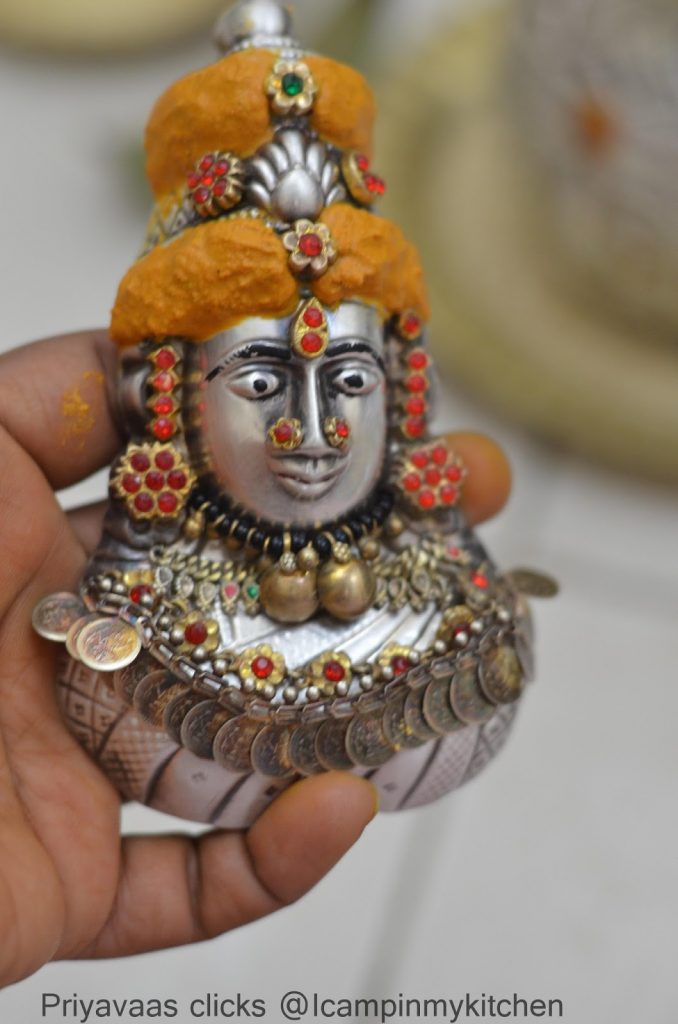
The Kalasam
Decorate the Silver pot/kalasam with Chandan/Sandalwood and vermilion. Add the items, in the list given below one by one.
- Rice ( 2 heaped cups)
- dried dates 5 nos
- 5 raisins
- Vetrilaai/Betel leaves
- 5 nos betel nut
- 5 nos 1 re coins/silver coins
- Vermilion and turmeric (small boxes)
- Kaatholai karugamani/
- one ripe lemon
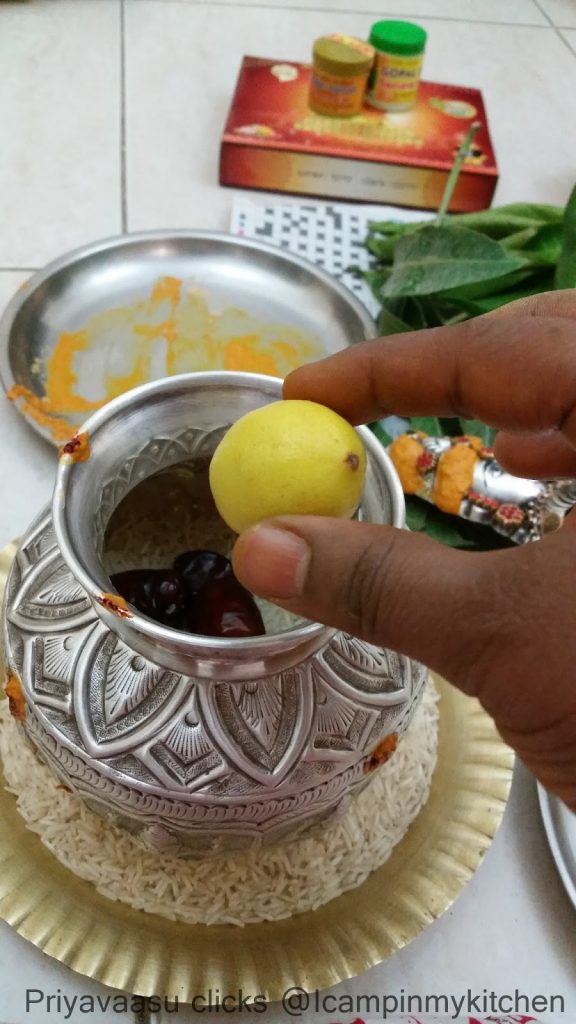
First add rice to the silver pot/kalasam, next add dried dates, followed by raisins, coins, betel leaves, vermilion and turmeric, lemon, and kaatholai karugamnai, which is very important.
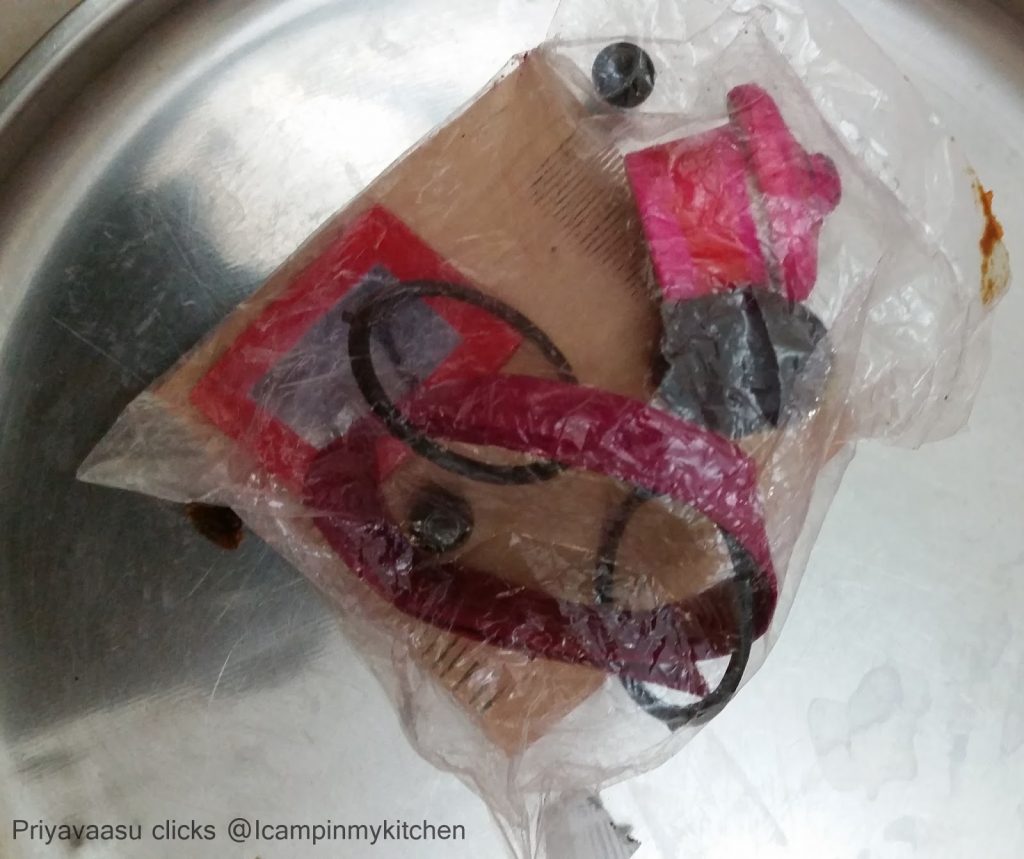
Insert a bunch of fresh mango leaves in the center. Add fresh thazhampoo/fragrant screwpine flower petals. Place a coconut smeared with turmeric at the mouth of the pot.
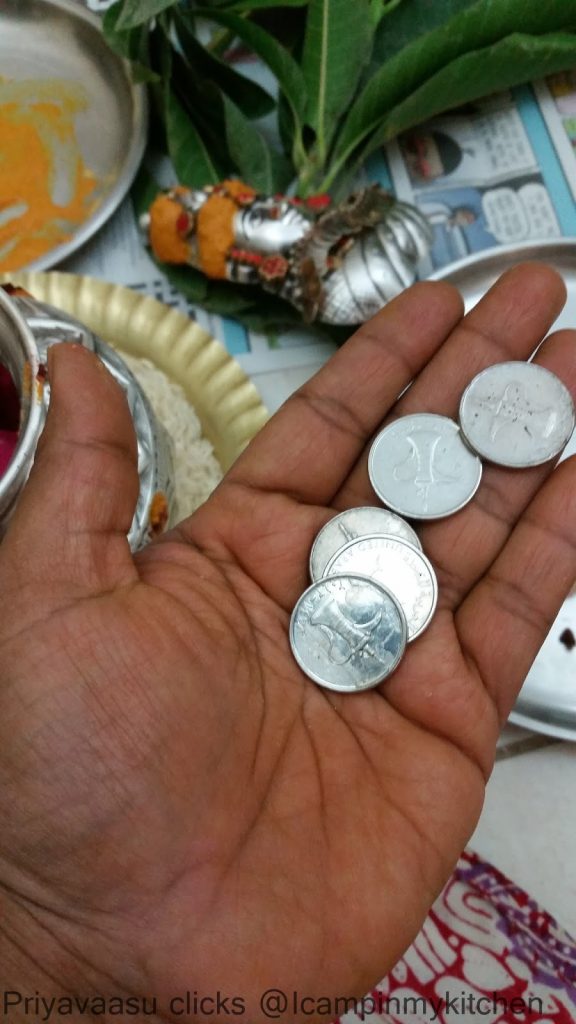
Take care to buy a good coconut that will sit nicely on the pot(size matters). Adjust the mango leaves and the screw-pine flower to come neatly around the coconut. to look like a blossoming flower with the coconut as the center.
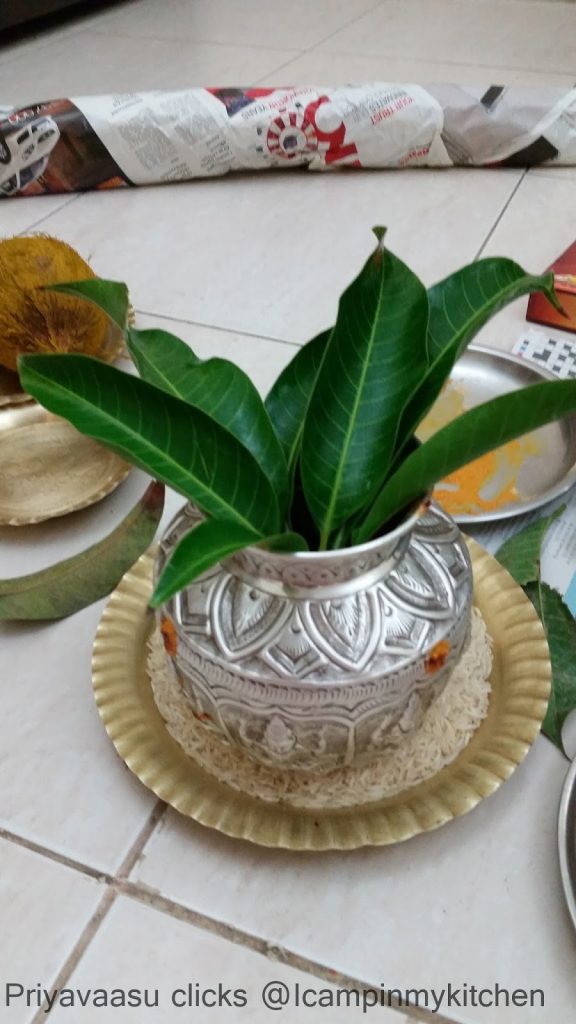
Dress the kalasam to look like a lady by tying a pavadai/skirt around its neck. We get ready-made skirts for the kalasam at Giri Trading or every famous shop selling traditional pooja materials. If you prefer, you can stitch pavadai/skirt with silk blouse material. Many tailors who are familiar with the customs know how to stitch one to fit the kalasam.
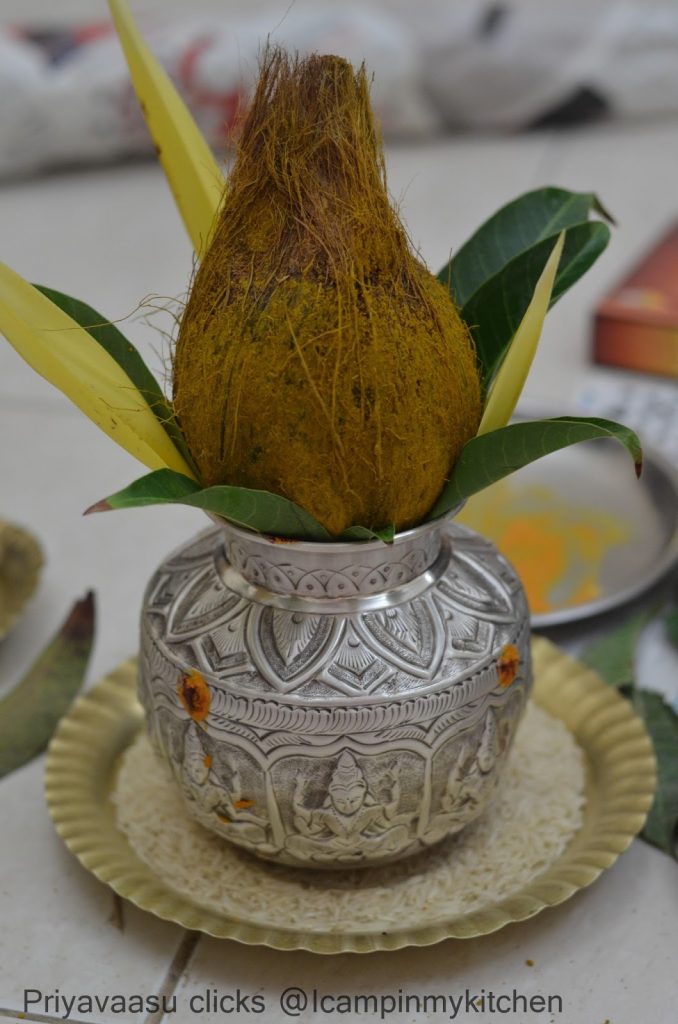
The Mugam/Goddess Face
The goddess face/mugam is inserted at the neck of the pot, where the coconut is placed. Some even place the mugam at the kudumi/fibrous cone-shaped portion on the coconut. According to our family traditions we do it at the neck of the kalasam.
Decorate the kalasam with jewels and fresh flowers. I use a little kajal to add more beauty to the eyes. I have a pair of thandu maalai which i put at each side of the mugam and a ready-made pearl jadai/hair decoration, which i placed at the back of the kalasam.
The entire setup would look like a lady sitting near you. Keep a small plate of rice on top of the mandapam, carefully place the kalasam/ambal on it.
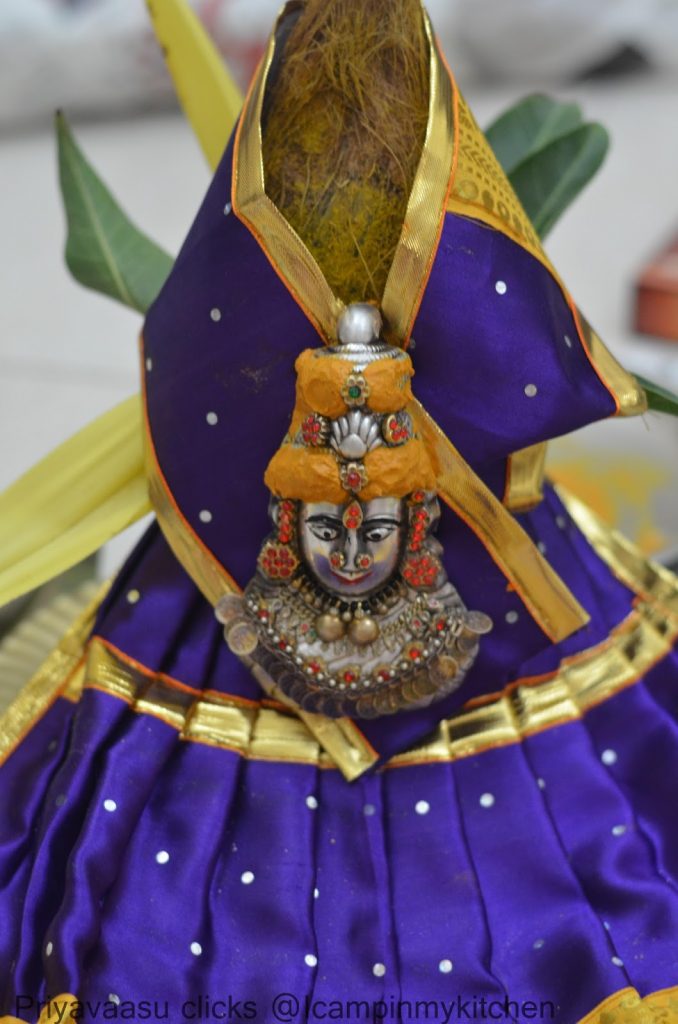
The Sacred thread
For Varlakshmi pooja, we tie a sacred yellow thread in our right wrist. In India, family priest brings a bunch of thread, weeks ahead of the pooja along with the necessary pooja items for avani avittam/Male thread changing function.If you are outside India, you can find them in Indian grocery stores near you.
I reside in Sharjah, we have a tamil flower shop in all prominent locations here, where they keep all items required for the pooja.
At home, it is me and ambal for the pooja, i keep 2 threads ready for the pooja. If the count including ambal is 3, keep it 4, as we generally don't prefer 3 counts.
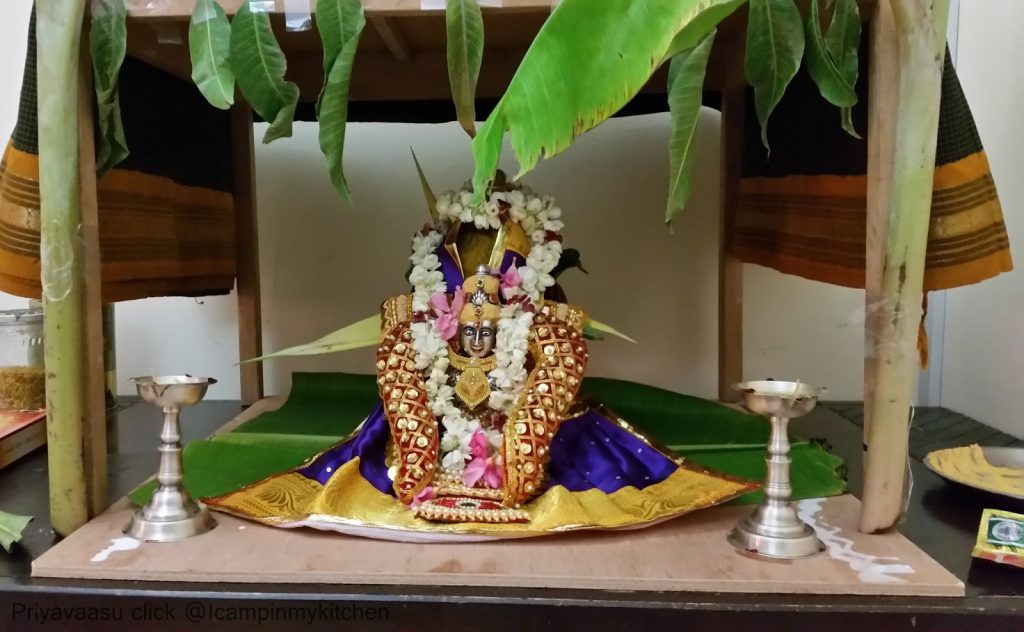
Varalakshmi Pooja day
The pooja can be done before or after raaghu kalam. Many prefer to do before raghu kaalam. if you have help at home, you can plan and do the work, so you can be ready for the pooja before raghu kalam.
I prefer to do after raghu kalam, finishing the neivedhiyam cooking and keeping things ready for pooja. This way i can dedicate my full attentions without worrying about the time.
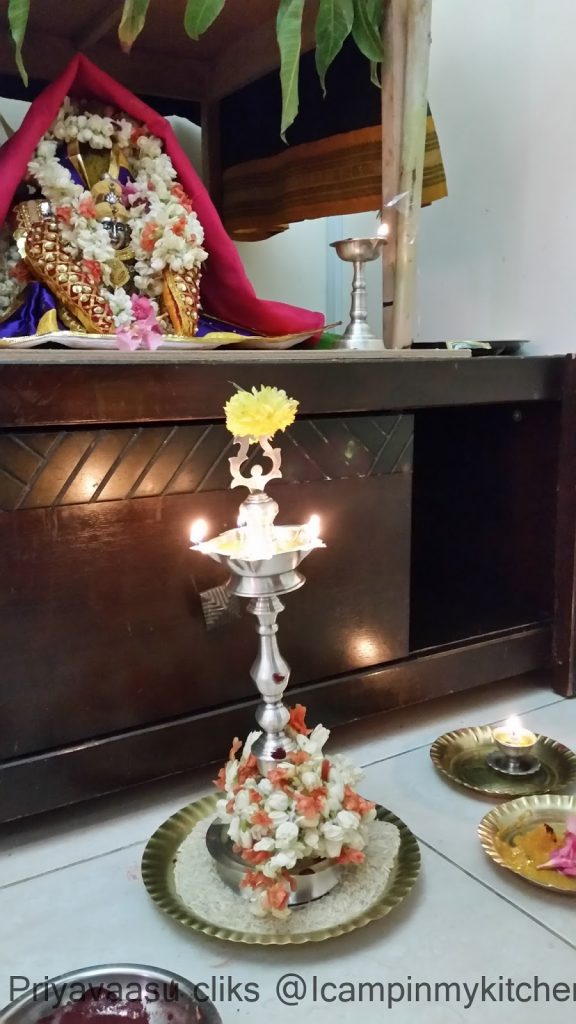
Neivedhiyam for the Pooja
Get ready with the Neivedhiyam first, which usually are
- Poorna kozhakattai,
- Raw-rice idly,
- Sundal
- Rice and toor dal,
- Paruppu vadai
- Sarkarai pongal or
- payasam
Pooja Checklist
Keep all the pooja requirements ready by your side.
- Manjal Kumkum/Vermillon & turmeric for the pooja
- Lamps and ghee/oil for the lamps
- Sacred yellow thread for the pooja with flowers tied to the center.
- flowers for archanai/pooja , ready in a big plate/thambalam
- Mani/pooja bell,
- thoobakaal/plate for camphor
- camphor cubes
- incense sticks,
- match stick
We normally wear Madisaar, on days we perform religious and traditional poojas. If not, wear a normal saree or a decent salwar kameez will do.
Prepping the Altar/Poojai mandapam
Keep a big banana leaf/Nuni ilai, inside the mandapam, with the pointed end facing left-side of the goddess. Place 2 cups of raw rice in the center of the banana leaf and spread it to a circle.
The Entrance
Put kolam/rangoli at the entrance, where you will be welcoming the goddess. Place a manai/palagai/wooden plank with kolam, carefully place the kalasam on that plank. Light a small diya/deepam/lamp. Make a small ganapthy/vinaygar using turmeric and do the vinayagar pooja and a small neivedhiyam to ganapathy, a piece of jaggery/banana. After dhoopam and deepam, it is time to bring the kalasam into the altar.
Welcoming the Goddess
Chanting these Mantra,
Thirumalin maarbil vazhum Lakshmi, Sri Vaikundathai AAlum Lakshmi,Devargal Potrum Mahalakshmi,Thiruvarul Puriya Vara vedum
Carefully lift the goddess along with the palaka/plank and come inside the house,walk slowly and carefully place the goddess inside the mandapam on the banana leaf laid with rice. If you have a lady or your daughter who can help, ask them to hold the other end of the palaga and slowly walk together.
Please remember, it's a delicate decoration and you are carrying the goddess herself, have bhaya and bhakthi together while carrying the kalasam.
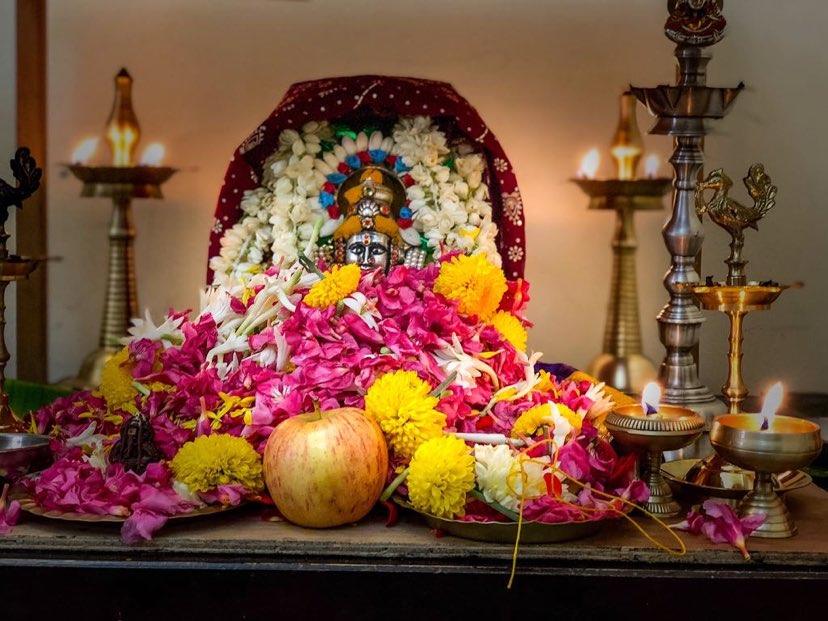
Youtube Video on how to decorate the Kalasam
Pooja Begins
Light lamps near the mandapam. The Vratha pooja book, contains all the details related to the pooja, i highly recommend to keep the book handy for all traditional pooja rituals. I m giving a general outline about Varalakshmi pooja. We start with Vinayagar pooja. Next is Sankalpam, chanting the day, year, thithi and naksthara and seeking goddess blessing for the whole family.
Next comes the kalasa pooja, where we invoke the almighty to come and adorn the kalasam and accept our pooja. Chant Lakshmi Ashtothram and do archanai. After the Neivedhiyam/Offering, we perform pooja for the Sacred thread which will be worn on the right hand.
After the sacred thread pooja, take a thread from the goddess and place it on a plate with fruits, vermilion and turmeric. If you are husband is at home, ask him to tie the thread on your right hand. Or else, the elder female in the family will tie the thread. It is ritual to do namaskaara/obeisances to the eldest in the family and seek their blessings.
This is how i perform the varalakshmi vratham pooja.
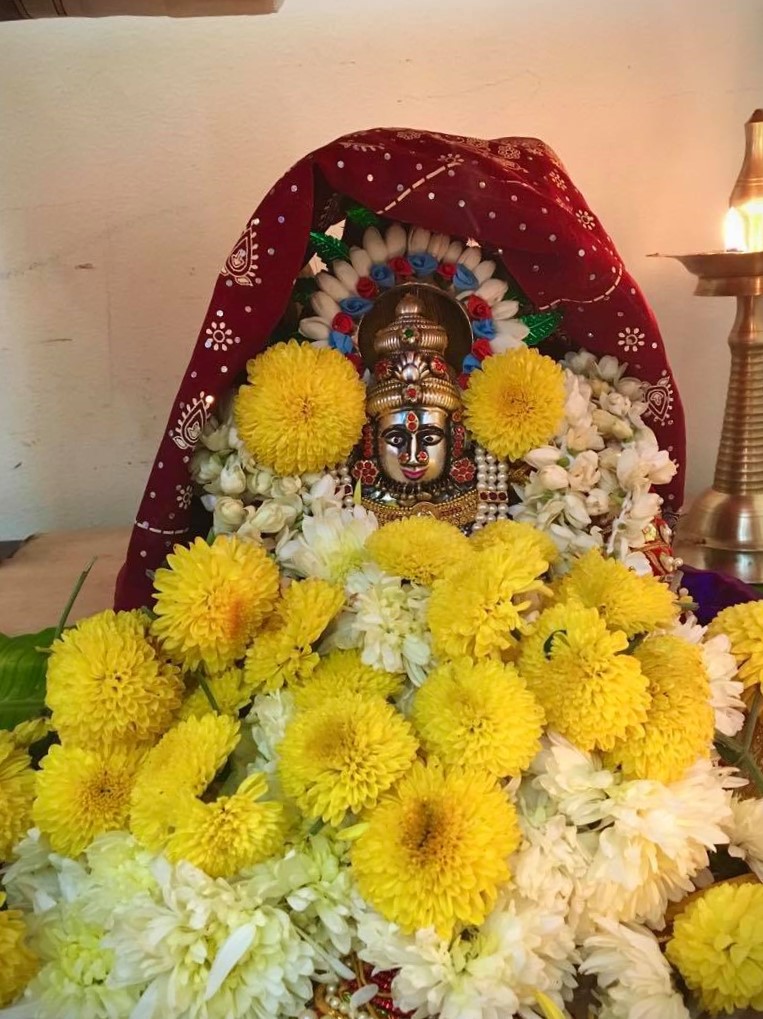
Next day/Punar Pooja
Next day again we do a simple pooja and neivedhiya/offering. Evening, after the lighting lamps, and a simple offering, we move the kalasam towards north symbolizing the end of the pooja. Before going to bed, place the kalasam in to a rice-pot. Next day morning, remove the decorations , use the rice for regular cooking and make sweet of the coconut and make lemonade of the lemon.


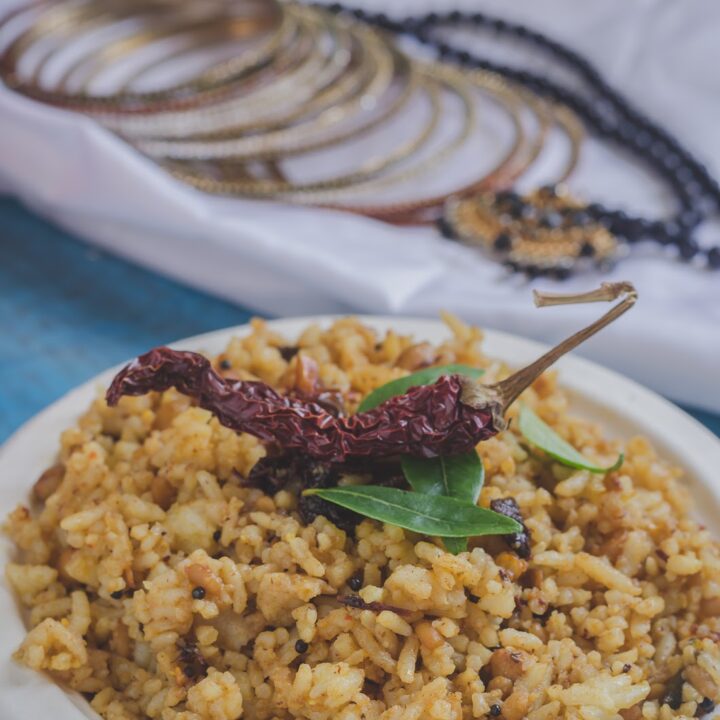
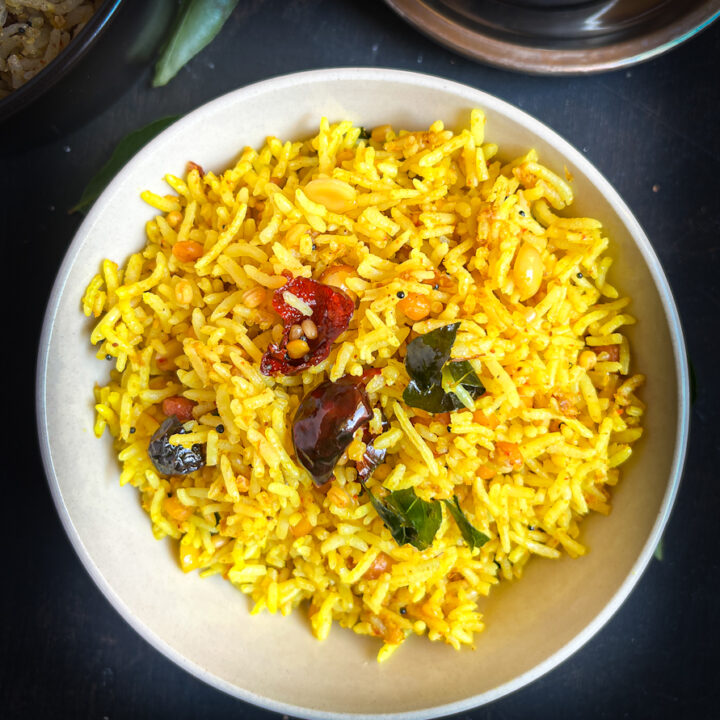
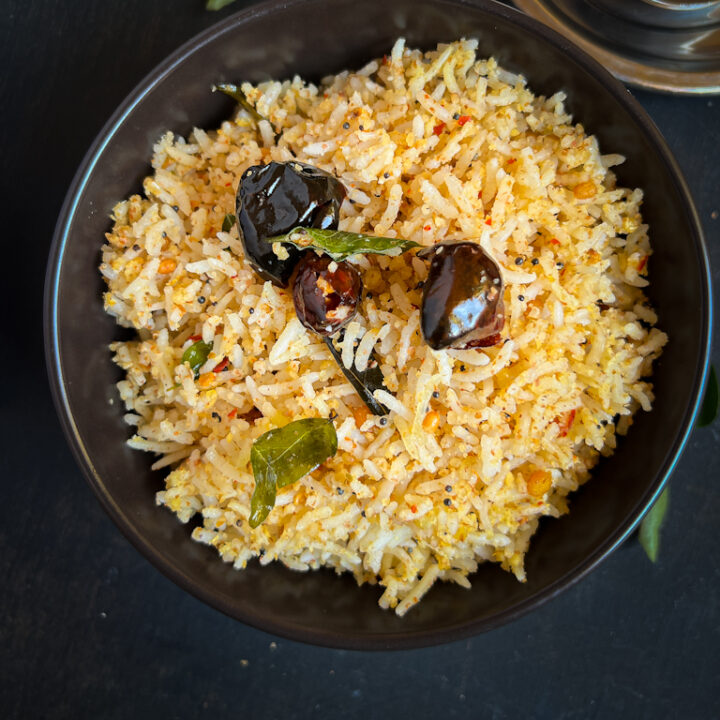
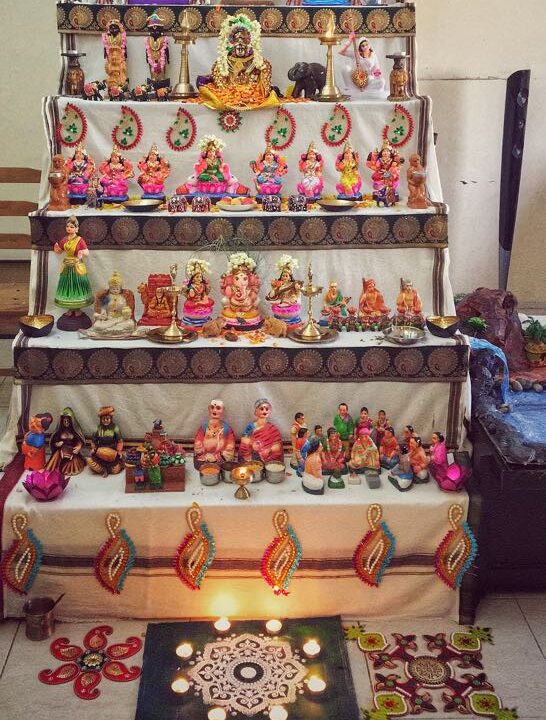
Unknown
so well explained Priya!!! love the clicks - so divine!!
Srivalli
Such a beautiful post Priya!..thanks for sharing...though I don't preform varalakshmi vratham, I do have a virtual Navrathri pooja..this is wonderful documentation...and to think you almost said no for doing this BM!..see how wonderfully you managed to cook for all days..you should listen to elders ok..:)..
Srividhya
well written and well explained. Great
MySpicyKitchen
Beautiful post on vratham. Thansk for sharing. Goddess face is beautiful and you have beautifully decorated the mandapam, kalsam and the goddess
vaishali sabnani
We don't do any poojas at home, but I love to see all these beautifully decorated pooja Thali , Kalash....I loved the Mandan you have created,it is so arty.., looks real cool, like a typical big mandap. The Kalash looks gorgeous and the idol that you have is absolutely stunning. A fantastic post.
Sandhiya
Such a detailed post and you explained it very well.
Harini R
A Very beautiful post. A slightly different procedure from ours but the essence is the same 🙂
Priya Suresh
Feel like visiting your place during this vratham, fantastic post and super detailed post Priya, again a fabulous write up.
Pavani
Very interesting to read about your traditions. We do the pooja in a different way. Nice to see the similarities and differences.
cookingwithsapana
Very nice reading about your tradition .We celebrate navratri but in different way.The kalash sthapana is almost same .Nice post.
Suma Gandlur
We don' do Kalasam for navratri, I think. And we do the Lakshmi pooja also differently, owing to regional diffrrences. I love your Lakshmi face, so beautifully decorated.
Archana
Priya I love your post thoughI have never done these poojas I know my mom participated in them. What a lovely tradition beautifully written and explained.
Unknown
Very nice post. Pics also superb.
Kalyani
I dunno how I missed this beautiful post, Priya ! I had an Iyer mami next door while growing up, and this brought back so many memories of the Vratham / pooja at her house ! lovely one, Priya 🙂
Jothsna
Hi Priya, new to your blog. I have a question about the Amman mugam. I was given this for safekeeping by a friend when she was going through a divorce but have now lost contact with this friend. In my family we don't have the tradition of doing varalakshmi nombu but I have been advised by elders that I mustn't keep the Amman mugam at home. Please advise as to how I can proceed. Thank you.
Priya_Srinivasan
Hi jothsna, usually people who don't have varalakshmi poojai, never buy the mugam. If u ask me I don't see any wrong in having the mugam, but it should Be kept out the 3 Days of varalakshmi vratham, you can keep it in your pooja room and keep it back after the festival. But if you feel odd, since you don't have the practice, you can very well give it to a temple or any friend who has the tradition of nombhu. I will also try to check with my mom regarding this.
Thanks for visiting my blog and for the question.
Jothsna
Hi Priya, thanks so much for your reply. It answers my question. Thahnks!
Anusha
Very well written... Iam able to visualise you performing it...
Anitha
Hi can we use same varalakshmi Mugam for navaratri ??? And kalasa for navaratri to be filled with water and other items ?? As we keep cocinusy for 9 days ....
Priya_Srinivasan
Hi Anitha, yes I use the same mugam for navrathri also.
I use the same items to be filled inside the Kalasam, except maavilai & thazhambu as it will dry.
Some have the tradition of neer/water Kalasam.